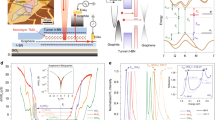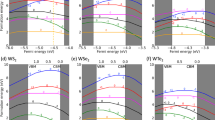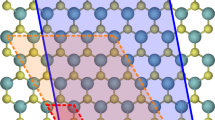Abstract
The electronic, optical and chemical properties of two-dimensional transition metal dichalcogenides strongly depend on their three-dimensional atomic structure and crystal defects. Using Re-doped MoS2 as a model system, here we present scanning atomic electron tomography as a method to determine three-dimensional atomic positions as well as positions of crystal defects such as dopants, vacancies and ripples with a precision down to 4 pm. We measure the three-dimensional bond distortion and local strain tensor induced by single dopants. By directly providing these experimental three-dimensional atomic coordinates to density functional theory, we obtain more accurate electronic band structures than derived from conventional density functional theory calculations that relies on relaxed three-dimensional atomic coordinates. We anticipate that scanning atomic electron tomography not only will be generally applicable to determine the three-dimensional atomic coordinates of two-dimensional materials, but also will enable ab initio calculations to better predict the physical, chemical and electronic properties of these materials.
This is a preview of subscription content, access via your institution
Access options
Access Nature and 54 other Nature Portfolio journals
Get Nature+, our best-value online-access subscription
$29.99 / 30 days
cancel any time
Subscribe to this journal
Receive 12 print issues and online access
$259.00 per year
only $21.58 per issue
Buy this article
- Purchase on Springer Link
- Instant access to full article PDF
Prices may be subject to local taxes which are calculated during checkout





Similar content being viewed by others
Data availability
The raw and processed experimental data and all the MATLAB source codes for the image reconstruction and data analysis will be freely available at www.physics.ucla.edu/research/imaging/sAET immediately after this work is published. The experimental 3D atomic coordinates of the two data sets will be deposited in the Materials Data Bank (MDB, www.materialsdatabank.org), with their MDB IDs provided in Supplementary Table 1.
References
Butler, S. Z. et al. Progress, challenges, and opportunities in two-dimensional materials beyond graphene. ACS Nano 7, 2898–2926 (2013).
Novoselov, K. S., Mishchenko, A., Carvalho, A. & Castro Neto, A. H. 2D materials and van der Waals heterostructures. Science 353, aac9439 (2016).
Fasolino, A., Los, J. H. & Katsnelson, M. I. Intrinsic ripples in graphene. Nat. Mater. 6, 858–861 (2007).
Terrones, H., Lv, R., Terrones, M. & Dresselhaus, M. S. The role of defects and doping in 2D graphene sheets and 1D nanoribbons. Rep. Prog. Phys. 75, 062501 (2012).
Yun, W. S., Han, S. W., Hong, S. C., Kim, I. G. & Lee, J. D. Thickness and strain effects on electronic structures of transition metal dichalcogenides: 2H-MX 2 semiconductors (M = Mo, W; X = S, Se, Te). Phys. Rev. B 85, 033305 (2012).
Warner, J. H. et al. Dislocation-driven deformations in graphene. Science 337, 209–212 (2012).
Zhang, C. et al. Strain distributions and their influence on electronic structures of WSe2-MoS2 laterally strained heterojunctions. Nat. Nanotechnol. 13, 152–158 (2018).
Lin, Y. C., Dumcenco, D. O., Huang, Y. S. & Suenaga, K. Atomic mechanism of the semiconducting-to-metallic phase transition in single-layered MoS2. Nat. Nanotechnol. 9, 391–396 (2014).
Li, H. et al. Atomic structure and dynamics of single platinum atom interactions with monolayer MoS2. ACS Nano 28, 3392–3403 (2017).
Wang, S., Robertson, A. & Warner, J. H. Atomic structure of defects and dopants in 2D layered transition metal dichalcogenides. Chem. Soc. Rev. 47, 6764 (2018).
Miao, J., Ercius, P. & Billinge, S. J. L. Atomic electron tomography: 3D structures without crystals. Science 353, aaf2157–aaf2157 (2016).
Scott, M. C. et al. Electron tomography at 2.4-ångström resolution. Nature 483, 444–447 (2012).
Goris, B. et al. Three-dimensional elemental mapping at the atomic scale in bimetallic nanocrystals. Nano Lett. 13, 4236–4241 (2013).
Chen, C.-C. et al. Three-dimensional imaging of dislocations in a nanoparticle at atomic resolution. Nature 496, 74–77 (2013).
Haberfehlner, G. et al. Formation of bimetallic clusters in superfluid helium nanodroplets analysed by atomic resolution electron tomography. Nat. Commun. 6, 8779 (2015).
Xu, R. et al. Three-dimensional coordinates of individual atoms in materials revealed by electron tomography. Nat. Mater. 14, 1099–1103 (2015).
Yang, Y. et al. Deciphering chemical order/disorder and material properties at the single-atom level. Nature 542, 75–79 (2017).
Zhou, J. et al. Observing crystal nucleation in four dimensions using atomic electron tomography. Nature 570, 500–503 (2019).
Borisevich, A. Y., Lupini, A. R. & Pennycook, S. J. Depth sectioning with the aberration-corrected scanning transmission electron microscope. Proc. Natl Acad. Sci. USA 103, 3044–3048 (2006).
Parr, R. G. & Yang, W. Density-Functional Theory of Atoms and Molecules (Oxford Univ. Press, 1989).
Rappe, A. M., Rabe, K. M., Kaxiras, E. & Joannopoulos, J. D. Optimized pseudopotentials. Phys. Rev. B 41, 1227–1230 (1990).
Onida, G., Reining, L. & Rubio, A. Electronic excitations: density-functional versus many-body Green’s-function approaches. Rev. Mod. Phys. 74, 601–659 (2002).
Sigiro, M., Huang, Y.-S., Ho, C.-H., Lin, Y.-C. & Suenaga, K. Influence of rhenium on the structural and optical properties of molybdenum disulfide. Jpn. J. Appl. Phys. 54, 04DH05 (2015).
Zhang, K. et al. Tuning the electronic and photonic properties of monolayer MoS2 via in situ rhenium substitutional doping. Adv. Funct. Mater. 28, 1706950 (2018).
Yang, S. Z. et al. Rhenium-doped and stabilized MoS2 atomic layers with basal-plane catalytic activity. Adv. Mater. 30, e1803477 (2018).
Crowther, R. A., DeRosier, D. J. & Klug, A. The reconstruction of a three-dimensional structure from projections and its application to electron microscopy. Proc. R. Soc. A 317, 319–340 (1970).
Frank, J. Three-Dimensional Electron Microscopy of Macromolecular Assemblies: Visualization of Biological Molecules in Their Native State (Oxford Univ. Press, 2006).
Pryor, A. et al. GENFIRE: a generalized Fourier iterative reconstruction algorithm for high-resolution 3D imaging. Sci. Rep. 7, 10409 (2017).
Tran, K. et al. Evidence for moiré excitons in van der Waals heterostructures. Nature 567, 71–75 (2019).
Seyler, K. L. et al. Signatures of moiré-trapped valley excitons in MoSe2/WSe2 heterobilayers. Nature 567, 66–70 (2019).
Meyer, J. C. et al. The structure of suspended graphene sheets. Nature 446, 60 (2007).
Meyer, J. C. et al. Direct imaging of lattice atoms and topological defects in graphene membranes. Nano Lett. 8, 3582–3586 (2008).
Bangert, U., Gass, M. H., Bleloch, A. L., Nair, R. R. & Eccles, J. Nanotopography of graphene. Phys. Status Solidi 206, 2115–2119 (2009).
Hofer, C. et al. Revealing the 3D structure of graphene defects. 2D Mater. 5, 045029 (2018).
Wang, W. L. et al. Direct imaging of atomic-scale ripples in few-layer graphene. Nano Lett. 12, 2278–2282 (2012).
Miró, P., Ghorbani‐Asl, M. & Heine, T. Spontaneous ripple formation in MoS2 monolayers: electronic structure and transport effects. Adv. Mater. 25, 5473–5475 (2013).
Brivio, J., Alexander, D. T. L. & Kis, A. Ripples and layers in ultrathin MoS2 membranes. Nano Lett. 11, 5148–5153 (2011).
Pavarini, E., Koch, E., Anders, F. & Jarrell, M. (eds) Correlated Electrons: from Models to Materials (Verlag des Forschungszentrum Jülich, 2012).
Wang, R. et al. Strategies on phase control in transition metal dichalcogenides. Adv. Funct. Mater. 28, 1802473 (2018).
Voiry, D., Mohite, A. & Chhowalla, M. Phase engineering of transition metal dichalcogenides. Chem. Soc. Rev. 44, 2702–2712 (2015).
Sun, X., Wang, Z., Li, Z. & Fu, Y. Q. Origin of structural transformation in mono- and bi-layered molybdenum disulfide. Sci. Rep. 6, 26666 (2016).
Ciccarino, C. J., Christensen, T., Sundararaman, R. & Narang, P. Dynamics and spin-valley locking effects in monolayer transition metal dichalcogenides. Nano Lett. 18, 5709–5715 (2018).
Komsa, H. P. & Krasheninnikov, A. V. Native defects in bulk and monolayer MoS2 from first principles. Phys. Rev. B 91, 1–17 (2015).
Gao, J. et al. Transition‐metal substitution doping in synthetic atomically thin semiconductors. Adv. Mater. 28, 9735–9743 (2016).
Kochat, V. et al. Re doping in 2D transition metal dichalcogenides as a new route to tailor structural phases and induced magnetism. Adv. Mater. 29, 1703754 (2017).
Van Dyck, D., Jinschek, J. R. & Chen, F.-R. ‘Big Bang’ tomography as a new route to atomic-resolution electron tomography. Nature 486, 243–246 (2012).
Chen, L.-G., Warner, J., Kirkland, A. I., Chen, F.-R. & Van Dyck, D. Snapshot 3D electron imaging of structural dynamics. Sci. Rep. 7, 10839 (2017).
Miao, J., Ishikawa, T., Robinson, I. K. & Murnane, M. M. Beyond crystallography: diffractive imaging using coherent X-ray light sources. Science 348, 530–535 (2015).
Jiang, Y. et al. Electron ptychography of 2D materials to deep sub-ångström resolution. Nature 559, 343–349 (2018).
Muller, D. A. Structure and bonding at the atomic scale by scanning transmission electron microscopy. Nat. Mater. 8, 263–270 (2009).
Pennycook, S. J. & Nellist, P. D. Scanning Transmission Electron Microscopy (Springer, 2011).
Dabov, K. & Foi, A. & Katkovnik, V. & Egiazarian, K. Image denoising with block-matching and 3D filtering. Proc. SPIE 6064, 606414 (2006).
Richardson, W. H. Bayesian-based iterative method of image restoration. J. Opt. Soc. Am. 62, 55 (1972).
Lucy, L. B. An iterative technique for the rectification of observed distributions. Astron. J. 79, 745 (1974).
Kirkland, E. J. Advanced Computing in Electron Microscopy (Springer, 2010).
Pryor, A., Ophus, C. & Miao, J. A streaming multi-GPU implementation of image simulation algorithms for scanning transmission electron microscopy. Adv. Struct. Chem. Imaging 3, 15 (2017).
Parzen, E. On estimation of a probability density function and mode. Ann. Math. Stat. 33, 1065–1076 (1962).
Acknowledgements
We thank M. F. Chisholm for support of the STEM experiment and C. Ophus for help with data analysis. This work was primarily supported by the US Department of Energy (DOE), Office of Science, Basic Energy Sciences (BES), Division of Materials Sciences and Engineering under award DE-SC0010378. It was also supported by STROBE: a National Science Foundation (NSF) Science and Technology Center under award DMR-1548924, by an Army Research Office MURI grant on Ab-Initio Solid-State Quantum Materials: Design, Production and Characterization at the Atomic Scale, and by the Division of Materials Research of the US NSF under award DMR-1437263. P.M.A. acknowledges support from the Air Force Office of Scientific Research under award FA9550-18-1-0072. The STEM experiment was conducted at the Center for Nanophase Materials Sciences, which is a DOE Office of Science User Facility.
Author information
Authors and Affiliations
Contributions
J.M. conceived and directed the project. Y.G. and P.M.A. synthesized the Re-doped MoS2 sample and measured the PL and Raman spectra, S.Y., X.T., D.S.K., J.C.I. and J.M. planned and/or performed the STEM experiments and X.T., D.S.K., J.M., Yongsoo Yang, Yao Yang and Y. Yuan discussed and/or performed 3D reconstruction, atom tracing and data analysis. C.J.C., B.D., P.N., D.S.K., X.T. and J.M. discussed and/or carried out DFT calculations. J.M., X.T. and D.S.K. wrote the manuscript with help and/or comments from all authors.
Corresponding author
Ethics declarations
Competing interests
The authors declare no competing interests.
Additional information
Publisher’s note Springer Nature remains neutral with regard to jurisdictional claims in published maps and institutional affiliations.
Extended data
Extended Data Fig. 1 3D atomic coordinates and crystal defects in data set 1.
a, Top view of the 3D reconstruction of data set 1. The inset shows the side view of MoS2 (panel 1), MoS2 with a Re dopant and a S vacancy (panel 2), and MoS2 with 3 S vacancies (panel 3), where arrows indicate the vacancies. Scale bar, 1 nm and scale bar (inset), 2 Å. b, 3D atomic model of the bounded region in (a), consisting of 1381 S, 686 Mo and 21 Re atoms with 15 S vacancies.
Extended Data Fig. 2 3D atomic coordinates and crystal defects in data set 2.
a, Top view of the 3D reconstruction. Scale bar, 1 nm. b, 3D atomic model of the bounded region in (a), consisting of 1083 S, 531 Mo and 16 Re atoms with 4 S vacancies. c, 3D plot of the Mo/Re layer showing atomics-scale ripples, where the dots represent the Mo/Re atoms. d, Histogram of the distribution of the z coordinates of the Mo/Re atoms in data set 1 with a standard deviation (σ) of 0.16 Å.
Extended Data Fig. 3 Least square fitting to determine the 3D coordinates of the Re and Mo atoms.
a, The x and y coordinates of the Re and Mo atoms were localized from the aligned projections of each data set. b, From these 2D coordinates, the tilt angles were calibrated and the 3D coordinates of the Re and Mo atoms were determined for each data set. The 3D atomic coordinates are consistent with those obtained by sAET with a RMSD of 2 pm and 13 pm for Mo (c) and Re (d) atoms, respectively, where a total of 1176 Mo and 32 Re atoms was used in the statistical analysis. Scale bar, 1 nm.
Extended Data Fig. 4 Multislice simulation results.
a, The experiment image versus the multislice image of the same region. b and c, The intensity profiles corresponding to labelled regions 1 and 2 in (a), where the high, medium and low intensity peaks represent the Re, Mo and S atoms, respectively.
Extended Data Fig. 5 Numerical simulations on the sAET reconstruction of a MoSe2-WSe2 heterostructure with moiré patterns.
a, Top view of the 3D reconstruction of double-layered heterostructure from 15 multislice projections with a double tilt range from −25° to +25°. b, Top view of 3D atomic model obtained from (a), where a 5˚ rotational mismatch between the top and bottom layers is visible. c, 6 atomic layers of the 3D reconstruction in the square region in (a), where atomic defects in each layer are labelled as blue circles. d, 6 atomic layers of the 3D model in the square region in (b), where traced defects are shown as red circles. The RMSD between the sAET reconstruction and the original atomic model is 8 pm, 5 pm and 13 pm for Mo, W and Se atoms, respectively.
Extended Data Fig. 6 Full 3D strain tensor of data set 1 (a) and data set 2 (b).
The six strain components are shown from left to right columns, and the three atomic layers are displayed from top to bottom. Scale bar, 2 nm.
Extended Data Fig. 7 Strain tensor maps of εxx (a), εyy (b), εzz (c) of the Mo/Re layer in the four supercells used in DFT calculations.
The four 6×6×1 supercells labelled with (a), (b), (c) and (d) correspond to those in Fig. 5e. Scale bar, 2nm.
Supplementary information
Supplementary Information
Supplementary methods, refs. 59–63, Tables 1 and 2 and Figs. 1–6.
Supplementary Video 1
3D sAET reconstruction of the Re-doped MoS2 monolayer (data set 1), showing the different intensity distribution of the Re, Mo and S atoms as well as the S vacancies.
Supplementary Video 2
3D atomic model of the Re-doped MoS2 monolayer (data set 1) determined by sAET, consisting of 1381 S (in yellow), 686 Mo (in blue), 21 Re atoms (in black) and 15 S vacancies (in pink). Compared to an ideal MoS2 atomic model (in lighter colors), the experimental model shows 3D crystal defects, atomic displacements and full strain tensors of the 2D material. The local strains induced by single Re dopants are also visible.
Rights and permissions
About this article
Cite this article
Tian, X., Kim, D.S., Yang, S. et al. Correlating the three-dimensional atomic defects and electronic properties of two-dimensional transition metal dichalcogenides. Nat. Mater. 19, 867–873 (2020). https://doi.org/10.1038/s41563-020-0636-5
Received:
Accepted:
Published:
Issue Date:
DOI: https://doi.org/10.1038/s41563-020-0636-5
This article is cited by
-
No ground truth needed: unsupervised sinogram inpainting for nanoparticle electron tomography (UsiNet) to correct missing wedges
npj Computational Materials (2024)
-
Three-dimensional atomic structure and local chemical order of medium- and high-entropy nanoalloys
Nature (2023)
-
Accurate real space iterative reconstruction (RESIRE) algorithm for tomography
Scientific Reports (2023)
-
Distinguishing atomic vibrations near point defects
Nature Materials (2023)
-
Carbon defect qubit in two-dimensional WS2
Nature Communications (2022)



